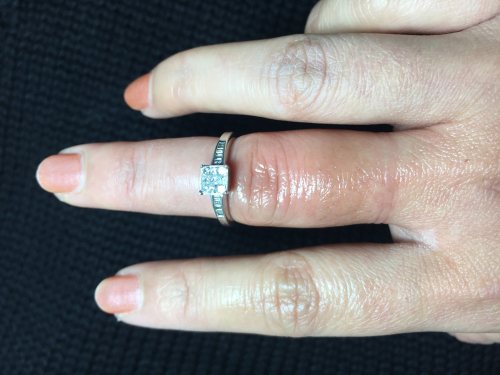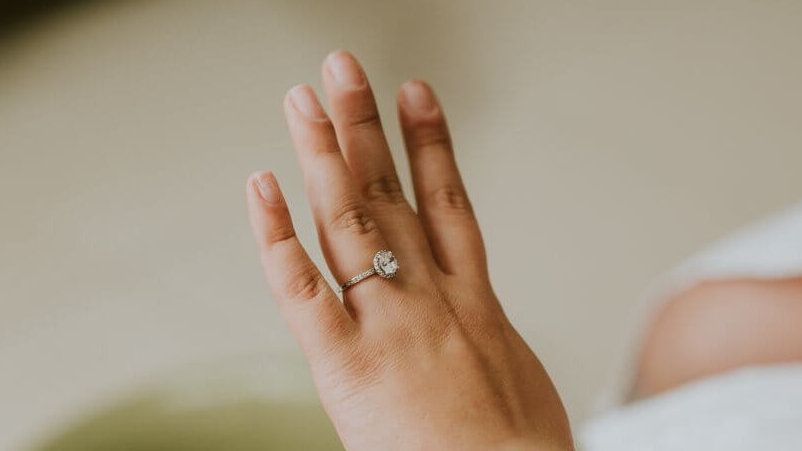Fat Fingers? Discover the Best Engagement Rings for You!

By Gary A.

Edited by Olivia H.
Published Dec 24, 2021
Edited on Dec 18, 2024
Finding the right engagement ring is all about balance, and for those with wider fingers, choosing the right design can make all the difference in creating a flattering, comfortable fit.

Navigate this guide:
- 9 Quick Tips for Buying a Diamond Engagement Ring and Resizing Considerations for Fat Fingers
- Introduction
- Engagement Ring Styles for Chubby Fingers
- Flattering Designs for Wider Fingers
- Our Expert Take
- 9 FAQs
Before we dive deeper into the specifics, here are some practical tips to help guide your decision-making process:
9 Quick Tips for Buying a Diamond Engagement Ring and Resizing Considerations for Fat Fingers
When purchasing a diamond engagement ring for fat fingers, there are several crucial factors to consider. This guide provides practical tips to ensure you find a ring that is not only beautiful but also comfortable and well-suited for a larger finger size.
- Tip 1: Opt for Elongated Diamond Shapes: For fat fingers, elongated diamond shapes such as oval, marquise, or pear can create an illusion of length and slimness. These shapes draw the eye along the finger, making it appear more slender.
- Tip 2: Consider Larger Stones or Halos: Larger diamonds or designs with halo settings offer more coverage on the finger, making the finger itself look more proportionate. These designs can balance the finger’s width without looking too small or getting lost.
- Tip 3: Select Wider Bands: Wider bands complement fat fingers better than thin bands. A band that is too narrow may look disproportionate and can even emphasize the finger’s width. A band width of at least 3mm is often recommended.
- Tip 4: Split Shank Designs: Rings with split shank designs can create a visual balance. They cover a wider area of the finger without adding bulk, which can be especially flattering for larger fingers.
- Tip 5: Ensure Proper Sizing: Accurate sizing is crucial for comfort, especially for fat fingers. The ring should fit snugly without causing any restriction or leaving indentations. Remember that finger size can fluctuate with temperature and time of day, so consider trying on rings at different times.
- Tip 6: Check for Smooth Edges: Ensure that the ring’s edges are smooth and rounded for comfortable wear. Sharp edges or rough finishes can dig into the skin, causing discomfort, especially in tighter fits.
- Tip 7: Explore Custom Designs: If standard ring designs don’t meet your needs, consider customizing a ring. Custom designs can be tailored to suit the size and shape of the finger perfectly while incorporating personal style preferences.
- Tip 8: Understand Resizing Limitations: Not all rings can be resized easily. The ring’s design, especially those with patterns or diamonds all around the band, can limit resizing options. Always inquire about the resizing potential before purchase.
- Tip 9: Choose Durable Metals: For fat fingers, it’s advisable to choose durable metals that can withstand daily wear and potential resizing. Metals like platinum and thicker gold are good choices as they offer durability and maintain their appearance over time.
Now that you’ve got these practical tips, use Jeweler AI below to find the perfect engagement ring that suits your style and budget:
Introduction
An engagement ring is a highly personal choice. We need to think about what our partners would love – what they might have hinted at – and what sorts of styles and shapes fit best with their unique personalities.
Then again, knowing our partners means knowing their hang-ups and trying to work out how to accommodate any insecurities or inhibitions they might feel over the way they style and dress themselves.
It’s pretty difficult for any wearer not to be flattered by a classic diamond ring, but there are a number of style choices you might want to consider if you know your bride-to-be will be eager for her ring to complement her short or chubby fingers as much as possible.
Engagement Ring Styles for Chubby Fingers
Many people find that the most flattering shapes are those that appear elongated, rather than those that are perfectly square or round in appearance.
Take a look at this Round Cathedral Engagement Ring, then compare it with this Oval Solitaire. While both rings are pretty stunning examples of ‘the classics’ – and the Round diamond has the edge when it comes to sparkle – the Oval cut diamond certainly wins out when it comes to flattering wider or stubbier fingers.
It’s a pretty common trick in fashion and jewelry – playing with proportion to create a grow or shrink one part of the body.
The same goes for the Marquise cut and the Pear.
Similarly, if you’re looking at the more geometric cuts, then we’d recommend you look at the Emerald diamond rather than the Asscher (square Emerald).

Flattering Designs for Wider Fingers
Halo and Pavé Settings for a Luxurious Look
A halo is an incredibly popular setting choice for flattering wide or chubby fingers since it adds extra weight (and width) to the ring without forcing you to drop tens of thousands of dollars on a much higher carat weight. Pavé on its own can be enough to flatter any finger because that extra brilliance and fire will draw the eye away from anything but the diamonds themselves.
As well as using proportion to your advantage in the diamond, you can intentionally design the setting to work with your fiancée-to-be’s fingers. After all, while the diamond solitaire is the classic choice for engagement rings, smaller diamonds can have the unwanted effect of making the finger look wider than it is. Sure, a 4 or 5 carat diamond will be big enough to work with a wider finger, rather than against it, but not everyone can accommodate that in their budget.
This Pear Halo Engagement Ring, for instance, makes use of the extra weight and sparkle provided by the halo, which creates a silhouette significantly larger than the diamond alone.
Alternatively, you might want to consider a pavé band, like this Radiant Cut Pavé Engagement Ring in White Gold, as this feature will spread the sparkle across the full width of the top of the finger, rather than keeping it solely at the center.
Some people also find that split shank settings are highly effective at slimming the finger since they take up more space rather than carving a single line across what is generally considered the widest part of the finger.

Ring Size for Comfort: A Crucial Component
One of the most important things to remember is the importance of a good fit.
Sure, you can angle your choices toward the most flattering shapes and styles, but there’s no escaping the fact that no finger will be flattered by a ring that doesn’t fit properly. Whether your bride-to-be’s fingers are on the short and ‘stubby’ side, or long and slim, a ring that is too tight will distort the edges of the wearer’s finger, and detract from its own beauty.
For that, you’ll want to accurately measure the intended wearer’s finger before choosing your design.. Start off by reading our full guide to choosing a ring size, then work out your approach to getting that vital number without letting the cat out of the bag.
Just remember that you could pick the most flattering ring style and diamond cut on the planet; if the shank is tight enough to bite into the fleshy part of the finger, however, it won’t do the wearer any favors. Plus, you’ll have to go for a ring resizing – something no newly engaged couple wants to have to do.
Metal Options
Your choice of metal only matters so far as personal preference, since both platinum and gold – whether white, yellow, or rose – are considered highly flattering for any skin tone or body type.
Again, ensuring a good fit really is key here. Other than that, your partner’s preference for a specific color of metal should be your guiding light – and, of course, your budget.
Whether you opt for a vibrantly yellow 18 karat gold or a bright platinum, the metal is bound to create a certain amount of contrast between the wearer’s finger and the ring itself – and, of course, the diamond. Remember that picking a ring that flatters the finger, and picking something that stops the wearer’s finger from standing out, are two totally different things, and it’s far more likely that you would both prefer the former, rather than the latter.
Our Expert Take
For starters, nobody ever looks worse when they’re wearing diamonds. Furthermore, if you are keen to pick something out that intentionally flatters your partner’s finger shape, there are plenty of ways to do that.
From playing with proportion to using shapes that elongate, rather than widen, some of the most popular and prized engagement ring designs naturally favor unique finger shapes. You don’t necessarily need to go out of your way to flatter your partner’s wide or chubby fingers – and, if you know a classic Round Brilliant Solitaire is what she’s always dreamed of, you definitely shouldn’t do that.
At the end of the day, people look their best in what they love, so focus on designing something you know she will fall for at first sight. Focus on ensuring that you get a great fit for her finger the first time around – and putting a smile on her face that lasts until bedtime.
9 FAQs
- Q: What diamond shapes are best for fat fingers?
- A: Elongated diamond shapes like oval, marquise, or pear are ideal for fat fingers as they create an illusion of length and slenderness.
- Q: Are wider bands better for fat fingers?
- A: Yes, wider bands tend to look more proportional and can make the finger appear slimmer compared to narrow bands.
- Q: Can any ring be resized to fit a fat finger?
- A: Not all rings can be resized, especially those with intricate designs or full diamond bands. It’s important to check the resizing potential before purchasing.
- Q: What is a split shank design in rings, and why is it suitable for fat fingers?
- A: A split shank design features a band that splits as it approaches the center stone. It offers a wider coverage on the finger, making it suitable for fat fingers.
- Q: How do I ensure the ring fits comfortably on a fat finger?
- A: Ensure accurate sizing and opt for rings with smooth and rounded edges. It’s recommended to try on rings at different times as finger size can change slightly.
- Q: Are halo settings a good choice for fat fingers?
- A: Yes, halo settings add extra width and coverage, making the center stone appear larger and more proportionate on fat fingers.
- Q: What metal is recommended for engagement rings for fat fingers?
- A: Durable metals like platinum and thicker gold varieties are recommended as they withstand daily wear and potential resizing well.
- Q: How can I make my fat fingers appear slimmer with a ring?
- A: Choose elongated diamond shapes, wider bands, and designs like halos or split shanks to create a slimming effect on the finger.
- Q: Is it possible to customize a ring for a fat finger?
- A: Yes, many jewelers offer custom ring designs that can be tailored to fit and flatter a fat finger perfectly. 10. Do certain ring styles make fat fingers look thicker? Answer: Yes, very thin bands or small stones can accentuate the width of the finger. Opting for proportionate designs is key.
Explore Jeweler AI for a tailored selection of engagement rings, perfectly fitting every unique finger shape.
FOLLOW-UP GUIDE SERIES

